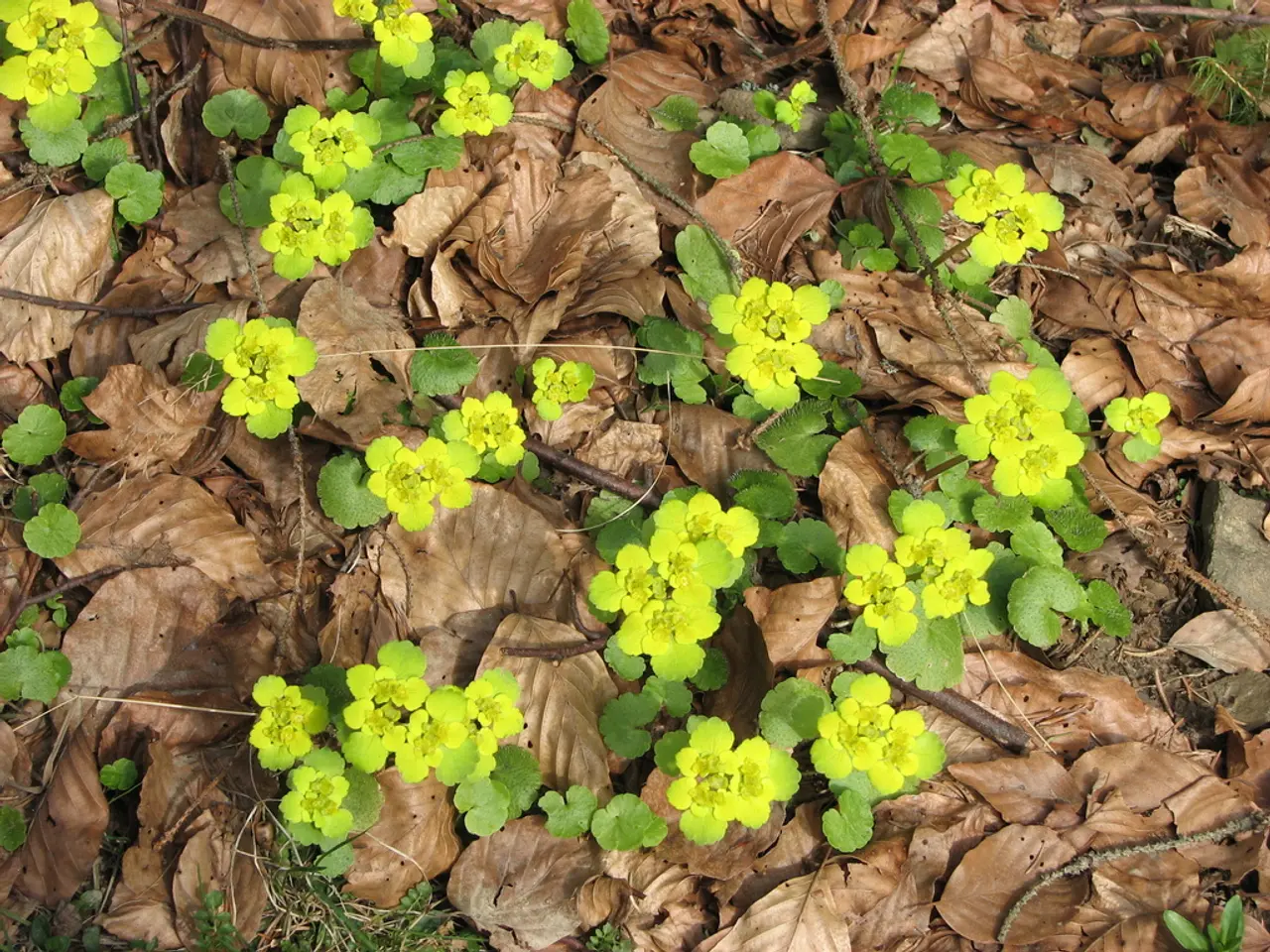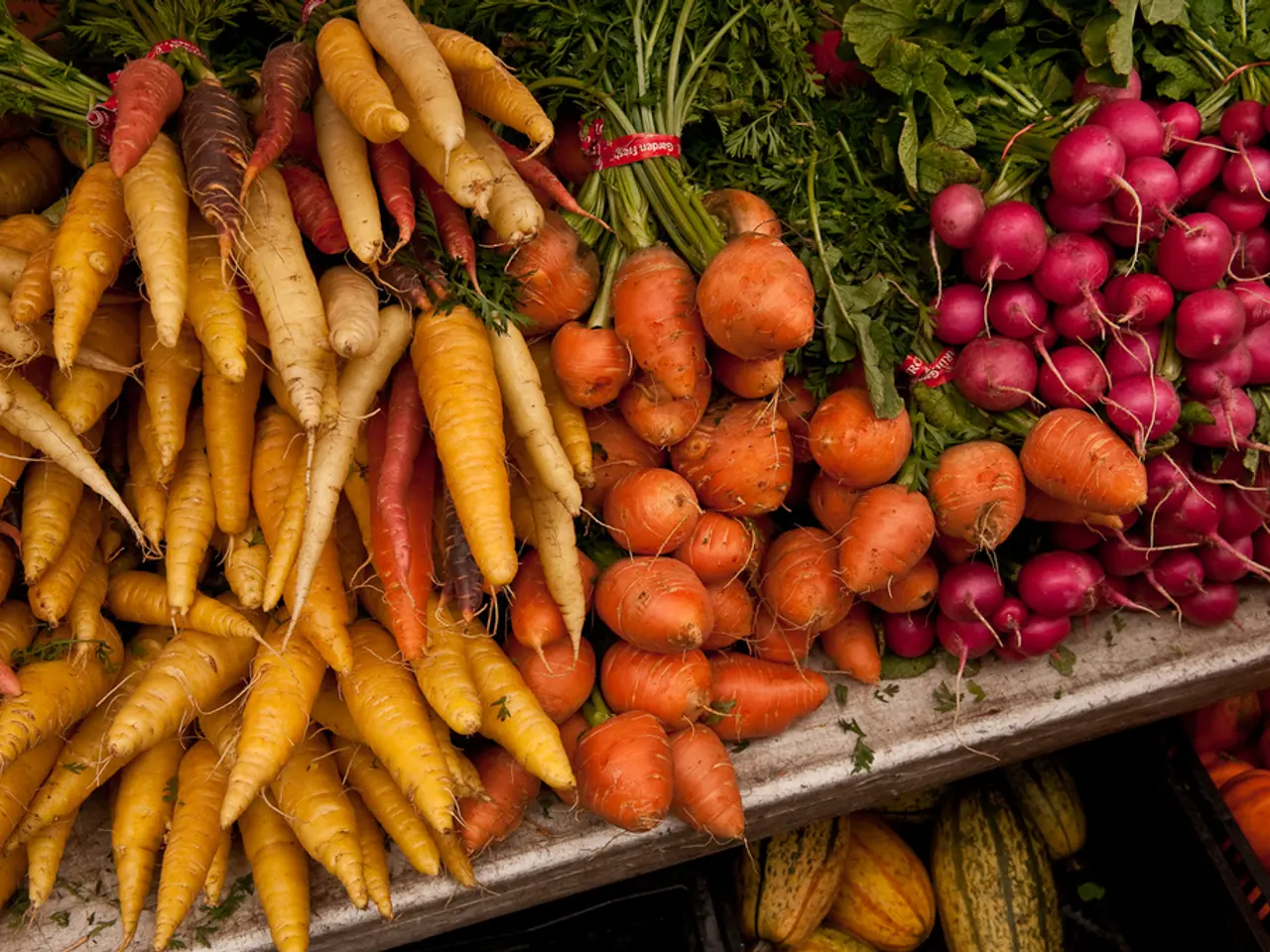Struggles of Plants in Salty Soil: Consequences and Adaptations Strategies
**Addressing High Soil Salinity: Strategies for a Healthier Agriculture**
High soil salinity, a common issue caused by the accumulation of soluble salts such as sodium, chlorides, sulfates, and carbonates, poses significant challenges to plant growth by inhibiting water and nutrient uptake. To combat this issue, a multi-faceted approach is needed, addressing both soil and plant responses, and encompassing physical, chemical, and biological methods.
**Soil Amendments**
One effective strategy involves the use of soil amendments. Flue Gas Desulfurization Gypsum (FGD) and biochar, for instance, can help regulate soil pH, replenish essential minerals, and reduce salinity in saline-alkali soils. FGD gypsum specifically helps displace sodium ions with calcium, improving soil structure and reducing sodicity. Biochar enhances water retention and nutrient availability, further supporting plant resilience. Humic-based amendments, like humalite, also mitigate salinity stress in marginally salt-impacted soils, restoring some level of productivity.
**Irrigation and Water Management**
Strategic interventions in irrigation practices can also play a crucial role. Drip irrigation, for example, helps leach salts from the root zone, preventing their accumulation and reducing salt stress—a particularly valuable approach for crops like cotton in saline environments. Proper water management, including the use of good-quality irrigation water, is essential to avoid exacerbating salinity. In regions with seasonal rainfall, natural leaching can reduce topsoil salinity during wet periods. Artificial leaching, where possible, can also be employed to flush out excess salts from the soil profile.
**Plant-Specific Interventions**
Products like Phylgreen, based on biostimulation principles, can enhance a plant’s metabolic response to salinity, enabling better self-management of salt stress and extending protective effects throughout the growing season. Cultivating salt-tolerant crop varieties or using genetic engineering to improve salinity tolerance can significantly boost yields in affected areas. Selecting crops that are naturally more resistant to salt stress is a practical, long-term solution.
**Integrated Soil Fertility Management**
Excessive nitrogen application can worsen salinity; thus, balanced and judicious use of fertilizers is key. Isotopic techniques can help optimize nutrient and water use efficiency, minimizing further soil degradation. Adding organic matter improves soil structure, water-holding capacity, and microbial activity, all of which help plants cope with salinity stress.
**Summary**
In summary, mitigating high soil salinity requires integrated approaches: amending soils with gypsum and organic materials, optimizing irrigation to leach salts, selecting or breeding salt-tolerant crops, and using biostimulants to enhance plant resilience. By combining these strategies, productivity and sustainability can be restored to salt-affected agricultural lands.
Sodium can cause soil dispersion, reducing infiltration and hydraulic conductivity. Salt stress can hinder seed germination, seedling growth, enzyme activity, DNA, RNA, and protein synthesis. The selection of salt-tolerant plant species is another strategy to consider for plants grown in saline soils. Salt stress can cause a reduction in leaf area, chlorophyll content, stomatal conductance, and photosystem II efficiency.
- The field of science, specifically environmental science, plays a crucial role in addressing high soil salinity, a persistent issue in agriculture.
- Health-and-wellness is closely tied to proper nutrition, which can be impacted negatively by soil salinity, making it essential to combat this issue.
- Fitness-and-exercise routines may require fresh produce, whose growth could be compromised by saline soils, highlighting the importance of addressing soil salinity.
- Climate-change can contribute to higher evaporation rates, which exacerbates soil salinity, underscoring the interconnectedness of these issues.
- Skin-care products often relies on agricultural products, making soil salinity a concern for the beauty and wellness industry.
- Nutritionists and dietitians should be aware of the potential effects of soil salinity on food quality and quantity.
- Cooking techniques and recipes may need to account for crops grown in saline soils to ensure proper nutrition and taste.
- Lifestyle choices, such as gardening or home-and-garden projects, can benefit from understanding the impact of soil salinity on plant growth.
- For instance, gardening in saline soils might require the use of salt-tolerant plants or specialized soil amendments.
- Data-and-cloud-computing tools can aid in monitoring and managing soil salinity levels in agriculture, thereby improving productivity.
- Environmental-science research can help develop strategies to mitigate climate-change effects, including soil salinity increase.
- Learning about gardening techniques, such as proper irrigation and soil amendments, promotes personal-growth and self-development.
- By increasing knowledge about soil salinity and its effects, career-development opportunities in agriculture, science, and environmental sectors may arise.
- Entertainment media can educate viewers about the importance of combating soil salinity and its connection to the food-and-drink industry.
- Understanding the impact of soil salinity on food production can facilitate education-and-self-development efforts, promoting awareness and responsible consumption.
- Learning about and implementing sustainable farming practices, such as managing soil salinity, contributes to personal-growth and self-improvement.
- Career-development in fields like agriculture, science, and environmental conservation can offer opportunities to address soil salinity, contributing to both career advancement and the betterment of the planet.
- Technology advancements can aid in the development of tools and techniques to better understand and mitigate soil salinity, benefiting numerous industries, including food-and-drink, and home-and-garden.
- Reading books on agriculture, environmental science, and sustainable living can provide insights into effective strategies for combating soil salinity.
- Education-and-self-development opportunities, such as online courses and workshops, can help individuals learn about soil salinity and its impact on plants, agriculture, and the environment.
- Sports, like football, champions-league, baseball, hockey, golf, sports-betting, basketball (NBA, NCAA), racing (premier-league, grand-prix, horse-racing), tennis, and mixed-martial-arts, rely on healthy agriculture, making it important to address soil salinity.
- Weather patterns can impact soil salinity levels, making accurate weather-forecasting and weather-analysis crucial for sustainable agriculture practices.
- In the context of global soccer leagues like laliga and premier-league, or tennis tournaments, understanding soil salinity can contribute to optimal sports-analysis and strategic decision-making.




